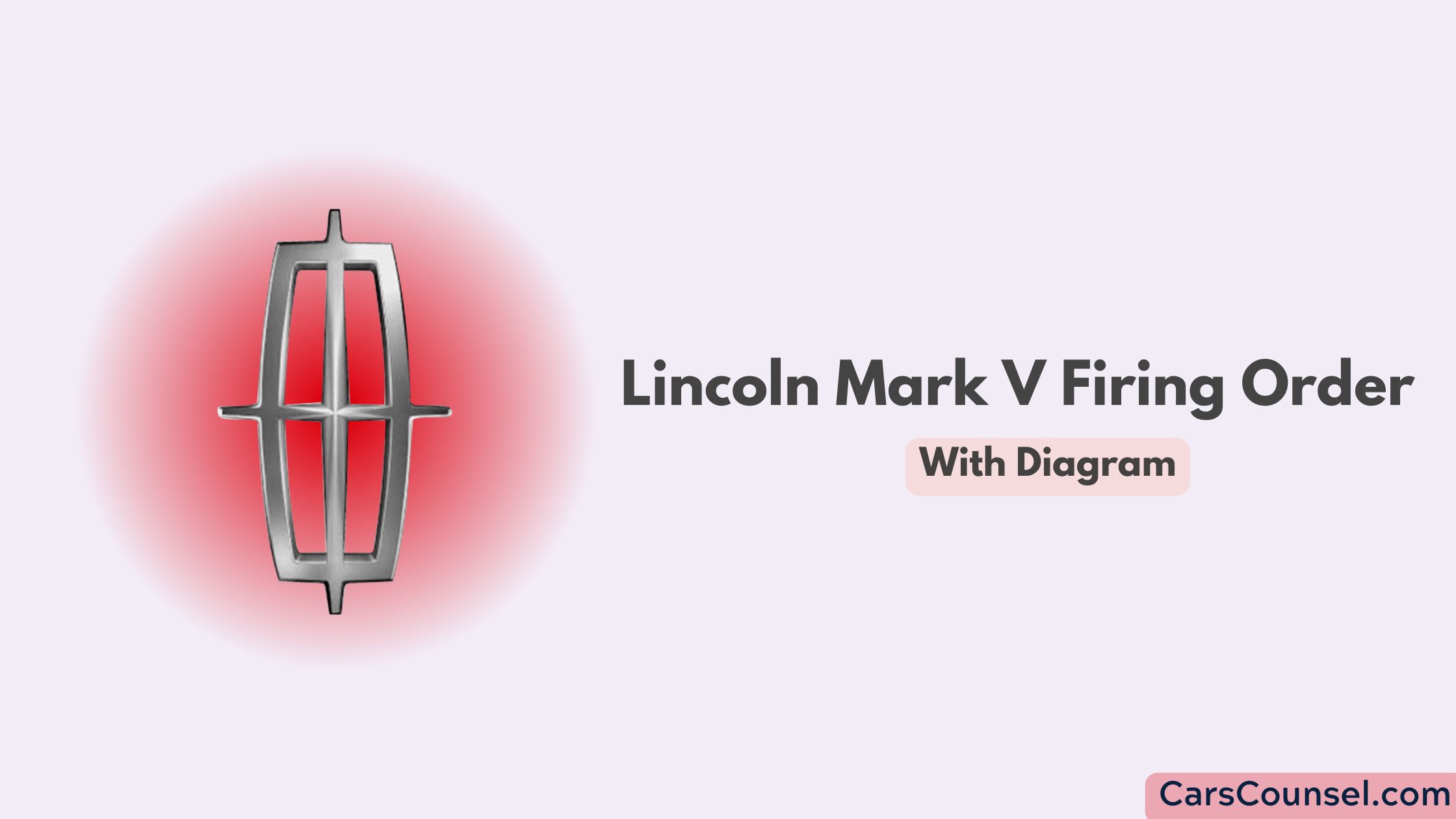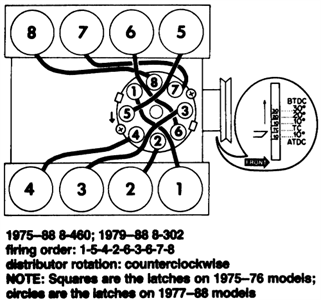The 1979 Lincoln Mark V is a classic luxury car with powerful V8 engine options. Understanding the firing order for this vehicle is crucial for effective maintenance, diagnostics, and performance tuning. This guide focuses on critical information you need to know, with a straightforward structure.

Quick Navigation
Firing Order for Both Engines
- 400 V8 and 460 V8 Firing Order: 1-5-4-2-6-3-7-8

This sequence ensures the engine operates smoothly and delivers consistent power.
What is the Firing Order?
The firing order defines the sequence in which the engine’s cylinders fire. For the 1979 Lincoln Mark V, the firing order depends on the specific engine configuration. Common engine options include the 400 cubic-inch V8 and the 460 cubic-inch V8.
Why the Firing Order Matters
- Smooth Operation: The correct firing order prevents vibrations and uneven performance.
- Efficient Combustion: Proper sequencing ensures optimal combustion in every cylinder.
- Engine Longevity: Balanced operation reduces wear and tear on components.
- Troubleshooting Aid: Knowing the firing order simplifies misfire diagnosis.
Cylinder Numbering and Layout
The V8 engine layout in the 1979 Lincoln Mark V uses a single-bank numbering system:
- Driver’s Side (Bank 1): Cylinders 1, 2, 3, 4.
- Passenger Side (Bank 2): Cylinders 5, 6, 7, 8.
Cylinder Numbering by Bank
- Bank 1 (Left): 1 (front), 2, 3, 4 (rear).
- Bank 2 (Right): 5 (front), 6, 7, 8 (rear).
This arrangement aids in identifying cylinders for maintenance and diagnostics.
Components Involved in the Firing Order
- Crankshaft: Coordinates piston movement and power delivery.
- Camshaft: Controls valve timing to sync with the firing sequence.
- Distributor: Directs spark to each cylinder in the correct order.
- Spark Plugs: Ignite the air-fuel mixture in each cylinder.
- Ignition Coil: Generates high-voltage energy for spark delivery.
Each component plays a key role in maintaining the correct firing order.
How the Firing Order Works
The V8 engine completes a combustion cycle every 720 degrees of crankshaft rotation. Each cylinder fires once per cycle. The firing order alternates power delivery across banks to balance the engine.
Key Phases of the Four-Stroke Cycle
- Intake Stroke: Cylinder draws in air-fuel mixture.
- Compression Stroke: Mixture compresses before ignition.
- Power Stroke: Spark ignites the mixture, creating combustion.
- Exhaust Stroke: Cylinder expels exhaust gases.
The firing order ensures these phases occur in harmony across all cylinders.
Common Problems with Firing Order
Misfires: A disrupted firing order causes uneven combustion.
- Symptoms: Rough idling, loss of power, backfiring.
- Causes: Faulty spark plugs, distributor issues, incorrect timing.
Power Loss: An incorrect sequence reduces engine efficiency.
- Solution: Verify distributor alignment and ignition components.
Vibrations: A mismatched firing order leads to unbalanced operation.
- Diagnosis: Inspect the timing system and distributor connections.
Engine Knock: Poor timing or improper firing can lead to knocking.
- Prevention: Maintain accurate ignition timing and use high-quality fuel.
How to Check the Firing Order
- Consult the Manual: Reference the owner’s manual or service guide for specifics.
- Inspect the Distributor Cap: Ensure wires connect to the correct cylinders in the firing sequence.
- Check Timing: Use a timing light to verify the ignition timing aligns with factory settings.
- Test Spark Plugs and Wires: Ensure proper voltage delivery and continuity.
- Perform a Compression Test: Verify even compression across cylinders.
Adjusting the Firing Order
The firing order in the 1979 Lincoln Mark V cannot be altered without significant engine modifications. However, you can maintain the correct sequence by ensuring:
- Distributor Alignment: Set the distributor to match the correct firing order.
- Spark Plug Installation: Confirm wires are routed to the proper cylinders.
- Timing Chain Position: Verify that the camshaft and crankshaft are properly synchronized.
- Ignition System Maintenance: Replace worn components, such as spark plugs or distributor caps.
Troubleshooting Firing Order Problems
- Listen for Misfires: Irregular engine sounds may indicate firing order issues.
- Inspect the Distributor Cap: Look for cracks, carbon tracking, or misalignment.
- Check Ignition Timing: Adjust timing if it deviates from specifications.
- Inspect Wires: Verify spark plug wires are securely connected and routed correctly.
- Use Diagnostic Tools: Test voltage output from the ignition coil and distributor.
Maintenance Tips for Optimal Firing Order
- Replace Spark Plugs: Regularly replace spark plugs as per the service schedule.
- Inspect Ignition Wires: Replace damaged wires to prevent electrical loss.
- Check the Distributor: Clean or replace the cap and rotor as needed.
- Maintain the Timing Chain: Replace the chain if it shows signs of wear or stretching.
- Use Quality Fuel: Prevent carbon deposits and detonation issues.
Performance Considerations
- Tuning: Retain the factory firing order for reliability when modifying or tuning the engine.
- Aftermarket Ignition Systems: Upgrade components to improve spark efficiency and engine response.
- Compression Testing: Ensure all cylinders have even compression for balanced power delivery.
Summary of Key Points
- Firing Order: 1-5-4-2-6-3-7-8 for both the 400 V8 and 460 V8 engines.
- Cylinder Layout: Bank 1 (1-2-3-4 on driver’s side), Bank 2 (5-6-7-8 on passenger’s side).
- Critical Components: Crankshaft, camshaft, distributor, ignition coil, and spark plugs.
- Common Issues: Misfires, power loss, vibrations, and engine knock.
- Maintenance Essentials: Replace spark plugs, inspect distributor, and maintain ignition timing.
Engines with Similar Firing Orders
- 2003 Lincoln Navigator Firing Order
- 2006 Lincoln Navigator Firing Order
- 2001 Lincoln Navigator Firing Order
- 2002 Lincoln Navigator Firing Order
- 2004 Lincoln Navigator Firing Order
Final Thoughts
The 1979 Lincoln Mark V firing order (1-5-4-2-6-3-7-8) is essential for ensuring smooth engine operation and reliable performance. By maintaining the distributor, ignition system, and timing chain, you can prevent common problems and extend the life of this classic car’s engine. Whether you’re performing routine maintenance or advanced tuning, understanding the firing order is key to keeping your Mark V running at its best.

